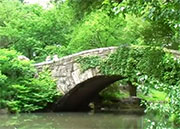- Strengthening Your Relationship: Practical Strategies
- Skip Storing This Everyday Product in the Fridge Door
- Green Tea + B3 Pairing May Boost Brain Health
- Navigating Your Midlife Crisis: Embracing New Possibilities
- City Raccoons Showing Signs of Domestication
- Mapping the Exposome: Science Broadens Focus to Environmental Disease Triggers
- One Week Less on Social Media Linked to Better Mental Health
- Your Brain Changes in Stages as You Age, Study Finds
- Some Suicide Victims Show No Typical Warning Signs, Study Finds
- ByHeart Formula Faces Lawsuits After Babies Sickened With Botulism
Green Space in Cities May Soothe the Heart


Turning vacant lots into attractive green plots may make life less stressful for city residents, a new study suggests.
The research included people in two Philadelphia neighborhoods who wore heart rate monitors when they went for walks in their area. Some vacant lots in one neighborhood underwent “greening” — which included cleaning, debris removal, planting grass and trees and installation of a low wooden post-and-rail fence.
The participants walked past the vacant lots three months before and three months after some of the lots received the greening treatment.
Being near green vacant lots was associated with an average heart rate reduction of more than five beats per minute, compared with non-greened lots. Further analysis concluded that the total net reduction in heart rate when near and in view of green vacant lots was more than 15 heart beats a minute.
“We used heart rate as a physiologic marker of acute stress, and the reduction we found suggests a biological link between urban blight reduction strategies like vacant lot greening and reductions in stress,” lead author Dr. Eugenia South, a physician in the department of emergency medicine at the University of Pennsylvania School of Medicine in Philadelphia, said in a university news release.
The study was published online March 19 in the American Journal of Public Health.
Previously, South and her colleagues had found that people who lived near greened vacant lots felt safer than those who live near non-greened sites.
“Our hypothesis in the earlier published work was that transforming vacant lots from being overrun with weeds and filled with trash to a clean and green space may make it difficult for people to hide weapons and conduct illegal activities such as drug use in or near the space,” South said.
“Thus, the lower heart rate response we found in the newly published study may be tied to residents feeling safer and experiencing less stress from their environment,” she concluded.
More information
The U.S. National Heart, Lung, and Blood Institute offers a guide to a healthy heart.
Source: HealthDay
Copyright © 2025 HealthDay. All rights reserved.










